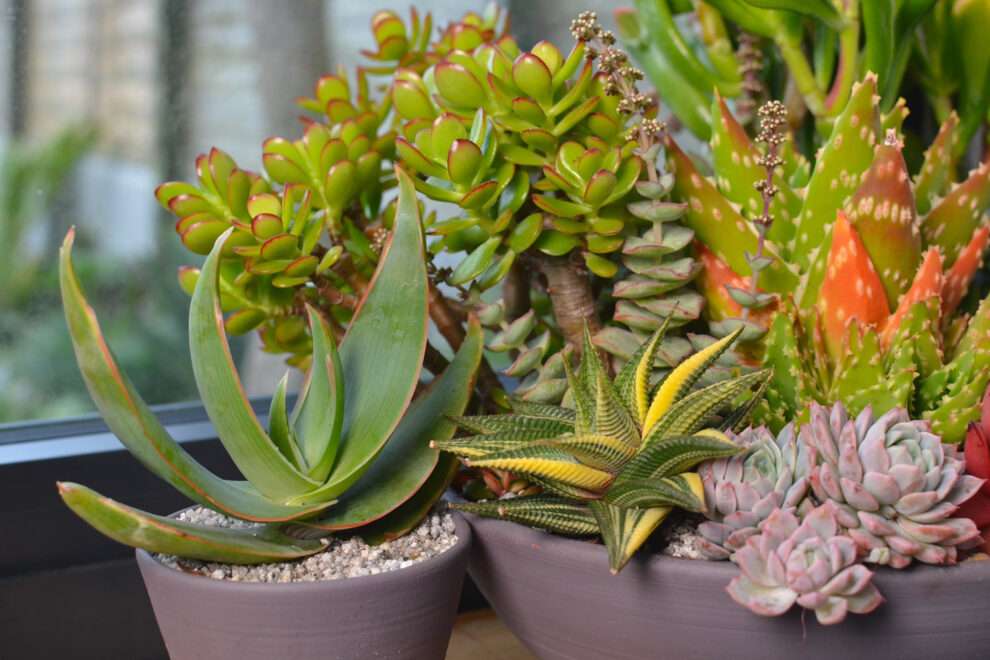Succulent plants are a unique and fascinating group of plants that have gained popularity in recent years. These plants are known for their ability to store water in their leaves, stems, and roots, allowing them to survive in arid and dry conditions. The word “succulent” comes from the Latin word “succus,” which means juice or sap, referring to the plant’s ability to retain water.
One of the defining characteristics of succulent plants is their thick and fleshy leaves. These leaves are often covered in a waxy or hairy coating, which helps to prevent water loss through evaporation. This adaptation allows succulents to thrive in environments with limited rainfall and high temperatures.
There are many benefits to growing succulent plants. Firstly, they are incredibly low-maintenance and require minimal care compared to other types of plants. Succulents are also highly adaptable and can be grown both indoors and outdoors, making them a versatile choice for any space. Additionally, succulents come in a wide variety of shapes, sizes, and colors, making them a popular choice for those looking to add visual interest to their gardens or homes.

Choosing the Right Succulent for Your Space
When choosing a succulent plant, there are several factors to consider. Firstly, you need to assess the available space where you plan to grow your succulent. Some succulents can grow quite large, while others stay small and compact. It’s important to choose a succulent that will fit well in your space and not outgrow its surroundings.
Another important factor to consider is the growing conditions of your space. Different succulent species have different requirements when it comes to sunlight, temperature, and humidity. Some succulents thrive in full sun, while others prefer partial shade. It’s important to choose a succulent that will be happy in the conditions you can provide.
There are many different types of succulent plants to choose from, each with its own ideal growing conditions. Some popular succulent plants for indoor spaces include the Aloe vera, Echeveria, and Haworthia. These succulents are well-suited to the lower light levels typically found indoors. For outdoor spaces, popular choices include the Agave, Sedum, and Sempervivum. These succulents can tolerate full sun and are often used in rock gardens or as ground cover.
Soil and Potting Tips for Succulent Care
One of the most important aspects of succulent care is providing the right soil and potting conditions. Succulents require well-draining soil to prevent root rot and other moisture-related issues. It’s important to choose a soil mix that allows excess water to drain away quickly.
There are several types of soil suitable for succulent plants. A popular choice is a cactus or succulent-specific potting mix, which is typically a blend of sand, perlite, and peat moss. This type of soil provides excellent drainage while still retaining some moisture for the plant’s roots.
When potting your succulent, it’s important to choose a pot with drainage holes to allow excess water to escape. Succulents do not like to sit in waterlogged soil, so it’s important to ensure that any excess water can drain away freely. Additionally, using a pot with a slightly larger size than the plant’s root system will allow for future growth and prevent overcrowding.
Watering Techniques for Succulent Plants
Proper watering is crucial for the health and survival of succulent plants. While these plants are adapted to survive in dry conditions, they still require regular watering to thrive. However, overwatering is one of the most common mistakes made by succulent owners and can lead to root rot and other issues.
The frequency of watering will depend on several factors, including the type of succulent, the size of the pot, and the environmental conditions. As a general rule, it’s best to water succulents when the soil is completely dry. This can be determined by sticking your finger into the soil up to the first knuckle. If the soil feels dry at this depth, it’s time to water.
When watering succulents, it’s important to thoroughly saturate the soil and allow any excess water to drain away. This ensures that the roots receive enough moisture without becoming waterlogged. It’s also important to avoid getting water on the leaves of succulent plants, as this can lead to rot and other issues.
Signs of overwatering include yellowing or wilting leaves, mushy stems, and a foul odor coming from the soil. On the other hand, signs of underwatering include shriveled or wrinkled leaves and a dry, brittle appearance. It’s important to pay attention to these signs and adjust your watering routine accordingly.
Lighting Requirements for Succulent Growth
Proper lighting is essential for the growth and health of succulent plants. These plants require bright light to thrive, but too much direct sunlight can cause sunburn and damage their leaves. Finding the right balance is key to ensuring optimal growth.
Succulents generally require at least six hours of bright, indirect sunlight per day. Placing them near a south-facing window is often ideal, as this provides ample light without exposing them to intense midday sun. If you don’t have access to natural sunlight, you can also use artificial grow lights specifically designed for plants.
There are several types of lighting suitable for succulent plants. Full-spectrum fluorescent lights are a popular choice for indoor succulent gardens, as they provide a balanced spectrum of light that mimics natural sunlight. LED grow lights are also a good option, as they are energy-efficient and can be adjusted to provide the right intensity and color temperature for succulents.
To provide adequate lighting for succulent plants, it’s important to position them close to the light source. This ensures that they receive enough light to fuel their growth. If using artificial lights, aim to keep them about 6-12 inches above the plants for optimal results.
Fertilizer Needs for Healthy Succulent Growth
While succulent plants are known for their ability to survive in nutrient-poor soils, they still benefit from regular fertilization. Fertilizing succulents can help promote healthy growth, vibrant colors, and overall plant vigor. However, it’s important to use the right type of fertilizer and apply it correctly to avoid damaging the plants.
When it comes to fertilizing succulents, it’s best to use a balanced, water-soluble fertilizer specifically formulated for cacti and succulents. These fertilizers typically have a higher phosphorus content, which promotes root development and flowering. It’s important to follow the instructions on the fertilizer packaging and dilute it to half strength or less to avoid overfertilization.
Fertilizing succulents should be done during the active growing season, which is typically spring and summer. During this time, you can apply the fertilizer every two to four weeks. In the dormant season, which is usually fall and winter, it’s best to avoid fertilizing altogether or reduce the frequency to once every two months.
When applying fertilizer, it’s important to water the plant thoroughly before and after to prevent burning the roots. It’s also important not to apply fertilizer to dry soil, as this can lead to salt buildup and damage the plant. Instead, water the soil first and then apply the diluted fertilizer solution.
Common Pests and Diseases Affecting Succulent Plants
Like any other plants, succulents are susceptible to pests and diseases. Common pests that can affect succulent plants include mealybugs, aphids, spider mites, and scale insects. These pests can cause damage to the leaves and stems of succulents, leading to stunted growth and overall decline.
To prevent pest infestations, it’s important to regularly inspect your succulents for any signs of pests. Look for small insects, webbing, or sticky residue on the leaves. If you notice any signs of pests, it’s important to take action immediately to prevent the infestation from spreading.
There are several methods for treating pest problems in succulent plants. One option is to use insecticidal soap or neem oil, which are both effective at controlling a wide range of pests. These products should be applied according to the instructions on the packaging and repeated as necessary.
In addition to pests, succulent plants can also be susceptible to diseases such as root rot and fungal infections. These issues are often caused by overwatering or poor drainage. To prevent these problems, it’s important to provide well-draining soil and avoid overwatering your succulents.
If you notice any signs of disease in your succulent plants, such as wilting or discoloration, it’s important to take action immediately. Remove any affected leaves or stems and adjust your watering routine if necessary. In severe cases, it may be necessary to repot the plant in fresh soil to prevent the spread of disease.
Propagation Methods for Succulent Plants
Propagation is an important aspect of succulent care and allows you to create new plants from existing ones. There are several methods of propagating succulent plants, each with its own advantages and challenges. By propagating your succulents, you can expand your collection and share plants with friends and family.
One common method of propagating succulents is through leaf cuttings. This involves removing a healthy leaf from the parent plant and allowing it to callus over before planting it in well-draining soil. Over time, the leaf will develop roots and a new plant will begin to grow.
Another method of propagation is through stem cuttings. This involves cutting a healthy stem from the parent plant and allowing it to callus over before planting it in soil. The stem will develop roots and eventually grow into a new plant.
Succulents can also be propagated through division, which involves separating the offsets or “pups” that grow at the base of the parent plant. These offsets can be carefully removed and planted in their own pots or areas of the garden.
Regardless of the propagation method you choose, it’s important to provide the right conditions for the new plants to grow. This includes using well-draining soil, providing adequate light, and watering appropriately. With time and care, your propagated succulents will grow into healthy and vibrant plants.
Seasonal Care for Succulent Plants
Succulent plants have different care requirements depending on the season. Understanding these seasonal changes can help you provide the best care for your succulents throughout the year.
During the spring and summer months, succulents are in their active growing phase. This is when they require more water and nutrients to fuel their growth. It’s important to water your succulents more frequently during this time, but still ensure that the soil has good drainage to prevent root rot.
In the fall, succulents begin to enter their dormant phase as daylight hours decrease and temperatures cool down. During this time, it’s important to reduce watering and allow the soil to dry out more between waterings. This helps mimic their natural environment and prepares them for winter dormancy.
Winter is a challenging time for succulent plants, especially those grown outdoors in colder climates. Succulents are not frost-tolerant and can suffer damage or even die if exposed to freezing temperatures. It’s important to protect your outdoor succulents by bringing them indoors or providing them with frost protection, such as covering them with a blanket or moving them to a sheltered location.
Indoor succulents also require special care during the winter months. The dry indoor air can cause their leaves to dry out and become crispy. To prevent this, it’s important to provide adequate humidity by placing a tray of water near the plants or using a humidifier.
Troubleshooting Common Succulent Care Problems
Despite their reputation for being low-maintenance, succulent plants can still encounter problems from time to time. Common problems in succulent care include overwatering, underwatering, pests, diseases, and improper lighting. It’s important to be able to identify and solve these problems to ensure the health and longevity of your succulents.
Overwatering is one of the most common problems in succulent care and can lead to root rot and other issues. If you notice that your succulent’s leaves are turning yellow or mushy, it’s a sign that you may be overwatering. To solve this problem, adjust your watering routine and allow the soil to dry out more between waterings.
Underwatering is another common problem and can cause succulents to become dehydrated and shriveled. If you notice that your succulent’s leaves are wrinkled or dry, it’s a sign that you may not be watering enough. To solve this problem, increase the frequency of watering and ensure that the soil is thoroughly saturated.
Pests such as mealybugs, aphids, spider mites, and scale insects can also be a problem for succulent plants. If you notice any signs of pests, such as small insects or webbing on the leaves, it’s important to take action immediately. Use insecticidal soap or neem oil to control the infestation and repeat as necessary.
Diseases such as root rot and fungal infections can also affect succulent plants. These issues are often caused by overwatering or poor drainage. To prevent these problems, ensure that your succulents are planted in well-draining soil and adjust your watering routine if necessary. If you notice any signs of disease, remove the affected parts of the plant and repot in fresh soil if necessary.
Maintaining healthy succulent plants requires regular care and attention. It’s important to monitor your plants for any signs of problems and take action immediately to prevent further damage. By providing the right conditions and addressing any issues that arise, you can enjoy healthy and vibrant succulent plants for years to come.
Conclusion
Succulent plants are a unique and fascinating group of plants that have gained popularity in recent years. These plants are known for their ability to store water in their leaves, stems, and roots, allowing them to survive in arid and dry conditions. Succulents are low-maintenance, adaptable, and come in a wide variety of shapes, sizes, and colors, making them a popular choice for both indoor and outdoor spaces.
When choosing a succulent plant, it’s important to consider factors such as space availability and growing conditions. Different succulent species have different requirements when it comes to sunlight, temperature, and humidity. It’s important to choose a succulent that will be happy in the conditions you can provide.
Proper soil and potting techniques are crucial for the health of succulent plants. Succ ulent plants are known for their ability to store water in their leaves, stems, and roots, making them well-suited for dry and arid conditions. To ensure their health and longevity, it is important to use well-draining soil that allows excess water to escape easily. This can be achieved by mixing regular potting soil with coarse sand or perlite to improve drainage. Additionally, using a pot with drainage holes is essential to prevent water from pooling at the bottom and causing root rot. When repotting succulents, it is important to gently remove the plant from its old container, being careful not to damage the delicate roots. Once in the new pot, the soil should be lightly packed around the plant, leaving enough space for air circulation. Finally, it is crucial to avoid overwatering succulents as they are prone to root rot. Instead, it is best to water them sparingly and only when the soil is completely dry.
If you’re looking for more articles related to caring for succulents, you might be interested in this comprehensive guide on angel numbers and their divine messages. Understanding angel numbers can provide insight and guidance in various aspects of life, including nurturing and tending to your plants. Check out the article here to discover the spiritual significance behind these numbers and how they can enhance your succulent care routine.

















Add Comment